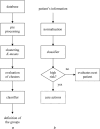Non-invasive method to analyse the risk of developing diabetic foot
- PMID: 26609394
- PMCID: PMC4611851
- DOI: 10.1049/htl.2014.0076
Non-invasive method to analyse the risk of developing diabetic foot
Abstract
Foot complications (diabetic foot) are among the most serious and costly complications of diabetes mellitus. Amputation of all or part of a lower extremity is usually preceded by a foot ulcer. To prevent diabetic foot, an automatic non-invasive method to identify patients with diabetes who have a high risk of developing diabetic foot is proposed. To design the proposed method, information concerning social scope and self-care of 153 diabetic patients was presented to the K-means clustering algorithm, which divided the data into two groups: high risk and low risk of developing diabetic foot. In the operational stage, the Euclidian distance from the information vector to the centroids of each group of risk is used as criterion for classification. Both real and simulated data were used to evaluate the method in which promising results were achieved with accuracy of 0.97 ± 0.06 for simulated data and 0.68 ± 0.16 considering the classification of specialists as the gold standard for real data. The method requires a simple computational processing and can be useful for basic health units to triage diabetic patients helping the health-care team to reduce the number of cases of diabetic foot.
Keywords: Euclidian distance; K-means clustering algorithm; automatic noninvasive method; computational processing; data classification; diabetes mellitus; diabetic foot; diabetic patients; diseases; foot complications; foot ulcer; health care; information vector; medical diagnostic computing; operational stage; patient diagnosis; pattern classification; pattern clustering; risk analysis; self-care; simulated data; social scope.
Figures
References
-
- Kaur H., Wasan S.K.: ‘Empirical study on applications of data mining techniques in healthcare’, J. Comput. Sci., 2006, 2, (2), pp. 194–200. (doi: )
-
- Antonelli D., Baralis E., Bruno G., Cerquitelli T., Chiusano S., Mahoto N.: ‘Analysis of diabetic patients through their examination history’, Expert. Syst. Appl., 2013, 40, (11), pp. 4672–4678. (doi: )
-
- Appuhamy J.A., Kebreab E., France J.: ‘A mathematical model for determining age-specific diabetes incidence and prevalence using body mass index’, Ann. Epidemio., 2013, 23, (5), pp. 248–254. (doi: ) - PubMed
LinkOut - more resources
Full Text Sources
Other Literature Sources




